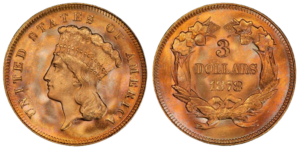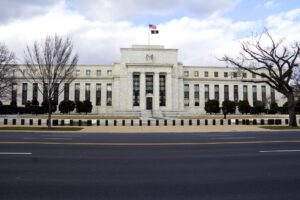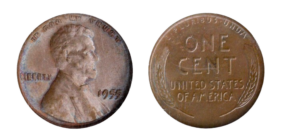A 1916 Gold Coin Honoring McKinley, Our Nation’s 25th President
Posted onPresident William McKinley, the 25th president of our nation, has been in the news recently. History buffs will recall that McKinley was president from 1897 until his assassination in 1901. He is known for leading America during a period of expansionism, which included the Spanish-American War, the annexation of Puerto Rico, Guam, the Philippines and Hawaii.
1897 until his assassination in 1901. He is known for leading America during a period of expansionism, which included the Spanish-American War, the annexation of Puerto Rico, Guam, the Philippines and Hawaii.
Recently, President Donald Trump has bestowed fresh honors upon McKinley.
President Trump signed an executive order to rename North America’s tallest peak, known as Denali in Alaska, after President William McKinley. The U.S. had originally named it Mount McKinley in 1917, which followed centuries of Indigenous groups calling it Denali, which means “the tall one” in the language of the Athabascan people. In 2015, the Obama administration formally recognized the mountain as Denali.
Beyond mountain names, President Trump has praised McKinley’s use of tariffs during his time in office. President Trump has already initiated a series of tariffs on several nations and says there will be more to come.
As our current president shines a fresh light on President McKinley’s tenure and accomplishments, a new rare coin offering has emerged, that is prized by numismatic collectors: the 1916 McKinley $1 gold coin.
The sale of the McKinley gold dollars helped pay for a memorial building for the fallen president at Niles, Ohio, which is featured on the commemorative gold coin’s reverse. The Memorial building design was created by George T. Morgan. The obverse of this handsome coin features a profile of McKinley facing left, and was designed by Charles E Barber.
These commemorative gold coins were minted in 1916 and 1917, with a total of 20,000 coins produced over that two year period.
Commemorative coins have a rich history and have been created for centuries. Popularized by the ancient Greeks and Romans, these coins record and honor important events. Today, commemorative coins are prized by collectors who typically seek to acquire and own by major types or in sets with mintmark varieties.
This offering reveals an opportunity for a collector to own not only a significant piece of history honoring a president with numerous accomplishments, but a president from our past with fresh ties to the present. See it here.
Dot.com Stock Boom Crashed 25 Years Ago: What Gold Investors Need to Know
Posted onHappy anniversary. Twenty-five years ago in March 2000, the dot.com stock market bubble began to burst. Looking back, in the mid-1990s, the dot.com era ushered in a period of explosive growth in information technology and the internet.
Depending on your age, you may not recall when Google didn’t exist for your everyday questions. For reference, Google was founded in 1998 and its search engine became popular in 2000. Before then, if you had a question, people went to the library and used Encyclopedias.
Any new start-up companies searching for capital simply had to add “.com” to the end of their firm name, and they quickly attracted generous venture capital. Many high-flying dot.com stocks never generated any revenue or became profitable, yet their stock prices soared wildly during the build-up to the stock market bubble top.
In 1999 alone, the NASDAQ grew an astonishing 86%. What happens next isn’t so pretty.
From the March 2000 top, over the next two years, the NASDAQ index crashed 77%, bottoming in October 2002. Ouch. That’s a big bust. The dot-com bubble burst opened the door to the economic recession in 2001.
What happened to gold during this time?

Historically, when the stock market plunges, gold prices rise – often substantially. During the dot-com crash years, investors piled into the safety of gold as their investments in the stock market deteriorated sharply and stayed low for over a decade.
From the NASDAQ’s October 2002 low, it took a long fifteen years, before that index set a new all-time high in April 2015. That’s a long time for stock market investors to wait.
Today, there are more than a few on Wall Street who point to the Magnificent Seven technology stocks and see parallels between the current artificial intelligence boom and the 2000 dot.com crash. The huge amount of speculative AI investment, the rapid growth and expansion, and the hype and high expectations around the outcome of future AI tools are eerily
similar. After all, despite billions of dollars of investment into big-tech AI tools, very few of them are profitable and many of these companies stock prices are climbing based on ideas of future potential profit—not actual revenue today.
For investors chasing the AI stock market boom, it’s worth considering the Latin phrase “caveat emptor” which simply means “let the buyer beware.”
Investors may also want to consider bolstering their allocation to gold today. That 77% decline in technology stocks during the dot.com crash was a tough pill for investors to swallow. Gold offers you protection for your wealth and an opportunity to grow your money even if the stock market turns down.
Want to read more? Subscribe to the Blanchard Newsletter and get our tales from the vault, our favorite stories from around the world, and the latest tangible assets news delivered to your inbox weekly.
The Full Report: Blanchard’s Exclusive Interview with Peter Boockvar
Posted onAs gold climbs to record highs, inflation rears its ugly head again and the Trump Administration makes big changes to government, trade and geopolitics, Blanchard spoke with esteemed money manager Peter Boockvar to help you make sense of the current investing environment.
and geopolitics, Blanchard spoke with esteemed money manager Peter Boockvar to help you make sense of the current investing environment.
Peter is the Chief Investment Officer at Bleakley Financial Group, a $10 billion wealth management firm and author of The Boock Report, which can be found on Substack. CNBC Fast Money viewers will recognize him as a frequent contributor where he offers his widely followed insights on stocks, the economy, gold and more.
In the wide-ranging discussion below, we uncover a plethora of important investing insights for you to consider now.
___________________________________________________________________________________________
Blanchard: What are the top three risks you see for the U.S. stock market and economy in 2025?
Peter Boockvar: I see three key risks right now. First, the Magnificent 7 stocks lose their dominance as investors question all their artificial intelligence spend and Apple loses its premium valuation because of little growth. Second, the bear market in bonds gets worse as interest rates continue to move higher. Lastly, high valuations in the U.S. leave little room for error.
Blanchard: Do you see risks for expanding military conflict over the next several years?
Peter: We do hope that the Russia/Ukraine war ends as well as the Israel/Hamas war, which could mean a potential downshift in active military conflicts. That said, Iran will remain a threat. And, we’ll be watching China and Taiwan closely.
Blanchard: What are your thoughts on gold’s role in a portfolio today?
Peter: Gold is an important investment asset to own because it’s a form of money. And notably, investors and foreign central banks around the world today want to own less dollars.
Blanchard: How might President Trump’s administration impact the price of gold?
Peter: They are discussing a possible revaluation from how the government currently marks gold reservesto the market price. The current government market value stands at $42, which is significantly lower than the market value of an ounce of gold around $2,926. This action could create a floor under the price of gold at whatever price the Trump Administration chooses to mark our nation’s gold reserves at.
Blanchard: How will the growing consumer demand for gold in India and China impact global gold prices?
Peter: The evidence of the impact is obvious with gold rallying in the face of higher interest rates and the U.S. dollars.
Blanchard: How is the ongoing central bank buying trend, particularly from developing countries, influencing gold prices?
Peter: Central banks should remain persistent gold buyers as they choose to reduce the percentage of their assets in U.S. dollars.
Blanchard: We just saw U.S. CPI jump higher to a 3.0% annual rate. Is gold an effective hedge against inflation?
Peter: Yes. Gold has maintained people’s purchasing power over the history of time much better than fiat currencies have.
Blanchard: How might the U.S. fiscal deficit and growing national debt influence gold prices in 2025?
Peter: Excessive U.S. debts and deficits have definitely caught the attention of the rest of the world. This is one reason why foreigners want to own less U.S. Treasuries and more gold.
Blanchard: What is your outlook for the U.S. economy this year and what could it mean for gold?
Peter: Currently, the U.S. economic outlook is mixed and uneven. There are three main factors powering the economic growth that we have seen. The first driver is high income spending, the second is artificial intelligence spending and thirdly, anything related to government spending. Notably, everything else has been weaker. Gold performs well in the stagflationary environment that we seem to be mired in.
Blanchard: After making 41 new record closing highs in 2024, gold has continued to set new records in early 2025. What does this trend suggest for gold in 2025?
Peter: In the short-term, gold is likely getting overbought. But I’m still positive on the outlook for the price of gold this year.
Blanchard: What are some of the factors that could push gold higher this year?
Peter: A continuation of current trends will continue to drive gold.
Blanchard: How do you see gold performing relative to other precious metals like silver and platinum this year?
Peter: Silver and platinum could catch up in performance.
Blanchard: Is now a good time to buy gold?
Peter: Yes.
Blanchard: If American investors don’t currently have an allocation to gold right now, what is your advice for them?
Peter: Get some.
If you’d like to discuss the content of this report with a Blanchard senior portfolio manager please give us a call today.
Want to read more? Subscribe to the Blanchard Newsletter and get our tales from the vault, our favorite stories from around the world, and the latest tangible assets news delivered to your inbox weekly.
The 1878 $3 Gold Coin: A Gem from the Industrial Revolution
Posted onIn 1878, the United States of America was in the midst of a major transformation from an agricultural society to an industrialized society—ushering in the Industrial Revolution. Collectors who own a coin from this period connect tangibly to this historical time when America emerged as an industrial giant and major economic power on the global stage.
Revolution. Collectors who own a coin from this period connect tangibly to this historical time when America emerged as an industrial giant and major economic power on the global stage.
The rapid construction of railroads opened up new parts of our nation for people to live and work and ushered in significant economic growth. Manufacturing and new inventions developed quickly, leading to the expansion of city living and urbanization.
During this period, the U.S. Mint in Philadelphia produced $3 gold pieces known as the Indian Princess Head. Many people are not even aware there was a three-dollar gold piece. It is a hidden gem in gold numismatics indeed. The Indian Princess Head $3 gold coin was minted from 1854 through 1889
If you are wondering why the U.S. Mint chose to produce a $3 coin, you aren’t alone. It is an odd number after all. Numismatic experts believe the reason can be found at the post office. When this coin was first minted a U.S. postal stamp cost 3 cents. The $3 coin created a convenient way for businesses to purchase 100 stamps in a single transaction!
The handsome design of this coin is memorable for anyone who has ever seen it in person or held it in their hand. Many consider the $3 Indian Princess one of the most beautiful gold coins struck in the 19th century. See the rich frosty luster and sparkling patina that comes with this 147-year-old masterpiece here.
James B. Longacre, the U.S. Mint’s chief engraver, designed the coin. Longacre was, for the first time, given the freedom to create a design of his own imagination. Previously, he had been instructed to rely on Roman or Greek features in U.S. coins. For the $3 gold coin, Longacre was determined to create something uniquely American.
Longacre chose to highlight an American “Indian Princess” on the obverse. A lustrous orange-gold color, the coin shows a lovely Indian Princess adorned with a feathered headdress, with the words UNITED STATES OF AMERICA circling her. On the reverse, the date and denomination are surrounded by an agricultural wreath celebrating corn, tobacco, cotton, and wheat.
Minted in Philadelphia of 90% gold and 10% copper, the total mintage came in at 82,304 coins. Survival estimates for all grades total 25,000, yet for grades 60 or better only 6,000.
In recent years, collector interest in three-dollar gold pieces has surged. Are you Interested in building a set? One idea is to aim to collect a four-mint set, which would include from each of the U.S. Mint facilities that struck the $3 gold coin: Philadelphia, Dahlonega, New Orleans, and San Francisco. You could start today with this 1878 $3 gold coin MS65 struck in Philadelphia. See it here.
Gold Revaluation Ideas Jump from Fringe to Mainstream
Posted onThe idea of gold revaluation has been on the perimeter of the gold community for decades. But, recent comments from U.S. Treasury Secretary Scott Bessent who said “We’re going to monetize the asset side of the U.S. balance sheet” moved the idea of valuing gold at current market price into the mainstream in a hurry.
a hurry.
What is gold revaluation?
Currently, the U.S. Treasury’s gold reserves are valued at about $11 billion—but that’s based on a legacy Bretton Woods gold price of $42.22 per ounce. The gold valuation price on the books is dramatically less than the current price of gold around $2,900 an ounce.
A revaluation would simply involve marking the price of U.S. government gold to the market price of around $2,900 an ounce (or whatever price the government decides).
With the simple push of an accounting pen, a revaluation to current market prices would instantly increase the value of the Treasury’s gold reserves to about $750 billion. The Treasury would essentially record on the books its unrealized gains of American government gold assets.
What could revaluation mean for the gold market?
This would instantly create a floor underneath the price of gold – in effect bringing us back toward a type of gold standard. A revaluation would also reinforce gold’s role in the global financial system – elevating it on equal standing of fiat currency.
What could this mean for the U.S. debt?
One of the benefits of gold revaluation for politicians is that it would instantly add money into the U.S. financial system without having to issue new Treasury bills, notes or bonds. This could be considered another form of quantitative easing and it would dramatically increase the size of the U.S. balance sheet.
For politicians struggling over the deficit and the upcoming debt ceiling challenge that means the Treasury has more money to pay the government’s bills – as the revaluation would in a sense – create new money out of thin air.
Bottom line? This would allow the U.S. Treasury to spend hundreds of billions of dollars without an increase to the national debt. Some on Wall Street warn this could be an inflationary move in and of itself. But, for gold investors that would continue to support rising trend in gold prices not only in the short-term, but over the medium and long-run as well.
Want to read more? Subscribe to the Blanchard Newsletter and get our tales from the vault, our favorite stories from around the world, and the latest tangible assets news delivered to your inbox weekly.
CPI Inflation Jumps, Eggs Prices up 15.2%. Gold Hits New Record Near $3,000
Posted onSpace enthusiasts will recall astronaut Jack Swigert’s famous message to NASA after an oxygen tank explosion rocked Apollo 13 while traveling to the moon in 1970:
“Houston, we have a problem.”
The same can be said for the Federal Reserve in 2025—when inflation moved in the wrong direction—jumping 0.5% to 3.0% in January, its biggest gain since August 2023.
August 2023.
The Federal Reserve has an inflation problem that won’t go away.
And, while egg prices soared 15.2% last month, the inflation jump isn’t just from eggs. Price increases on shelter, gasoline, and food (including meats, dairy, and fish) and higher used car and truck prices contributed to a broad rise in American consumer goods prices. Prescription medication and car insurance also saw big price jumps last month.
What’s more, these consumer price increases were recorded before the impact of any of President Trump’s new tariffs took effect. That means, there could be more jumps in inflation in the months ahead.
Markets react.
Stocks slumped on the news. Gold climbed to another record high. The precious metal has marched steadily higher since the beginning of the year and is already logging an impressive 11.2% gain as gold approaches the $3,000 an-ounce level. Silver is up 13% since the start of the year.
The surprise 3.0% CPI reading has many on Wall Street rethinking interest rate cuts this year. Many say Federal Reserve rate cuts have now moved to the back burner.
Bottom line?
Inflationary pressures are bubbling hot. Tariff policy could worsen the outlook in the months ahead. Investors should brace for higher volatility in the equity markets and the inflation trend will keep a strong bid under the gold market.
Gold has a rock-solid track record as a store of wealth and is an enduring form of money recognized in every country on the planet. Before stocks tumble more, have you considered rebalancing your portfolio and increasing your allocation to gold? Once stocks start crashing, it will be too late to get your money back.
Want to read more? Subscribe to the Blanchard Newsletter and get our tales from the vault, our favorite stories from around the world, and the latest tangible assets news delivered to your inbox weekly.
Will Elon Musk’s DOGE Get Rid of the Penny?
Posted onPresident Donald Trump signed an executive order on January 20, 2025 to establish DOGE: the Department of Government Efficiency, led by Elon Musk, with a goal to cut spending.

A number of programs, from diversity, equity, and inclusion (DEI) to Daylight Saving Time to the venerable one-cent piece—yes, the penny—are on the potential chopping block.
In an X post, DOGE wrote that it costs more than 3 cents to make a penny, which cost taxpayers over $179 million through 2023.
It’s true. The cost to make a penny jumped to 3.69 cents, according to the 2024 U.S. Mint annual report. That marks the 19th consecutive year that penny production costs have “remained above face value.” In 2024, the U.S. produced about 3.23 billion new pennies, according to the U.S. Mint. Pennies were the most produced coin in both 2023 and 2024.
In an increasingly cashless world, could Elon Musk be right? Is it time to ditch the penny? Cash usage has been declining due to the prevalence of credit cards, and debit cards, and the rise of mobile payment apps.
But, Americans still carry cash and use it. Forty-four percent of Americans say they use cash for some of their purchases, while 14% say they use it for all their purchases, according to a Pew Research Center study.
3 reasons DOGE may not be able to get rid of the penny
- To make change. For those Americans who do pay in cash, the penny is an essential tool to make change. How would you make change for an $11.97 purchase if you pay with a $20 bill without the penny?
- Getting rid of the penny could make things more expensive. Canada did away with its penny in the early 2010s—and now purchases there are rounded to the nearest nickel. For example, a $11.83 purchase becomes $11.85 in Canada now.
- Congress oversees our money. According to the U.S. Constitution, it is Congress (not DOGE) that is responsible for overseeing our money and coinage.
How much could the U.S. save if it got rid of the penny? Stopping production of the 1-cent piece could save taxpayers up to $100 million annually, according to a 2022 Federal Reserve report. Whether or not DOGE takes action to discontinue it, collectors will always prize and covet many special American 1-cent pieces. Halting future production of the penny could increase numismatic demand for existing rare pennies. Check out Blanchard’s current inventory of small cents here.
Want to read more? Subscribe to the Blanchard Newsletter and get our tales from the vault, our favorite stories from around the world, and the latest tangible assets news delivered to your inbox weekly.
Fed Hits Pause Button on Rate Cuts. Gold Starts January Strong
Posted onJust nine days after President Trump was sworn in as our nation’s new president, the Federal Reserve held interest rates steady at 4.25- 4.50%. Inflation remains above the Centrals bank’s target and there is widespread uncertainty on how the new administration’s policies will impact the economy and financial markets.
remains above the Centrals bank’s target and there is widespread uncertainty on how the new administration’s policies will impact the economy and financial markets.
This uncertainty likely played into the Fed’s decision to stand pat. Today’s decision from the Fed comes after three consecutive interest rate cuts in 2024.
For now, Fed chairman Jerome Powell side-stepped President Trump’s demand that the central bank lower interest rates, which the president announced to global business leaders last week at the World Economic Forum in Davos, Switzerland.
Gold Hits 3 Month High in Late January
In the markets, gold came out of the starting gates in January, trading virtually straight up from the $2,628 area in late December to above the $2,775 level in late January, marking a three-month high for the precious metal. The stock market plunged this week on worries of overvalued technology stocks. This triggered concerns that the AI-fueled stock market bubble could be ready to pop.
Inflation Remains above the Fed’s 2% Target
Economic data released since the December Fed meeting reveals that economic growth appears to be expanding at a strong 3% pace and the labor market remains solid, but progress on moving inflation back down to the Fed’s 3% target has stalled.
Looking back, consumer prices increased 2.9% in 2024, an improvement from 4.1% in 2023. However, progress bringing inflation back to its target at 2.0% has run into challenges as American’s are now concerned that tariffs could raise the price on imported goods.
Wall Street gets its next look at inflation on Friday, when the government releases the January personal consumption expenditures price index (PCE), which is widely known as the Fed’s preferred inflation gauge.
Batten down the hatches with gold
The new year is setting up to be a volatile one for the stock market, while the outlook for gold is glittering. After gaining almost 30% last year, January’s strong start for gold signals another big year for the precious metal, with analysts widely targeting the $3,000 an ounce level as the next big upside target.
If you haven’t already, now is the optimal time to increase your allocation to gold to hedge your portfolio against losses in the stock market. If the stock market plunges, your portfolio invested in equities shrinks, while the portion of your portfolio invested in gold grows. Questions? Blanchard is here to help.
Want to read more? Subscribe to the Blanchard Newsletter and get our tales from the vault, our favorite stories from around the world, and the latest tangible assets news delivered to your inbox weekly.
Gold Shines as Stocks Plunge on Worries about Chinese AI Tool
Posted onGold is shining—trading just below its record high—as the U.S. stock market tumbles amid concerns that a Chinese artificial intelligence company may provide cheaper and better technology than American tech firms.

Stocks tumbled in overseas trading to start the week and at the New York open, Nvidia crashed nearly 13%, wiping out over $400 billion in market value. In early action, the S&P 500 fell over 1.54%, the Nasdaq tumbled over 2.56% and gold is trading above $2,700 an ounce—not far from its all-time record high.
What you need to know about Chinese AI company: DeepSeek
A small Chinese start-up company called DeepSeek, founded in July 2023, launched a free AI tool that jumped to the top download in the Apple store, just seven days after its release. DeepSeek needs only a fraction of the data compared to U.S. tools to make it run and cost significantly less.
DeepSeek’s AI tool has upended Wall Street because of its low development costs—just over $5 million. By comparison, U.S. technology firms have routinely spent over $100 million to develop similar AI tools.
Is this a Sputnik moment?
The release of DeepSeek’s artificial intelligence tool has been likened to the “Sputnik moment” when the Russians first released a satellite into space in 1957. The United States confronted fears that there could be a technological gap between America and the Soviet Union.
Today, DeepSeek signals that U.S. technology firms, which are on track to invest over $1 trillion in AI over the coming years according to Goldman Sachs, may be behind in the AI race. The Chinese have seemingly discovered a way to produce similar or better results with lower-quality chips and significantly lower start-up costs.
What does this mean for U.S. stocks?
DeepSeek’s successful AI release raises questions over whether investors have overvalued U.S. technology stocks like Nvidia, Oracle, Meta, and Microsoft, which have been fueling the broader stock market’s advance. Some on Wall Street are warning this is the tipping point for the AI-fueled stock market bubble, and more significant losses could lie ahead—like the dot.com crash back in 2001.
How gold can protect your wealth
After two impressive years of gains, gold has cemented its position as an essential tool for portfolio diversification and risk management. Traditionally viewed as a safe-haven asset, gold provides investors the opportunity to protect, preserve, and grow their wealth even during periods of severe stock market volatility or downturn.
Gold has a proven track record of decoupling from stocks and climbing significantly when the stock market crashes. The unique characteristic of gold allows investors to hedge their portfolio against major bear market declines in the stock market and still grow their wealth during periods of crisis.
Whether or not DeepSeek turns out to be the pin that pricks the AI-stock market bubble, investors who own up to 10-15% of gold in their portfolios report better long-term returns with lower drawdowns.
If the stock market plunges, your portfolio invested in equities shrinks, while the portion of your portfolio invested in gold grows. Gold has a proven track record as insurance for your wealth. Take action today to ensure you keep more of the wealth you’ve worked hard to earn with an increased allocation to physical gold.
Want to read more? Subscribe to the Blanchard Newsletter and get our tales from the vault, our favorite stories from around the world, and the latest tangible assets news delivered to your inbox weekly.
Blame it on the Night Shift: The 1955 Lincoln Double Die Penny
Posted onThe 1955 Double Die Lincoln penny is easily the most famous double die coin in U.S. numismatic history. How did this dramatic error come about? Blame it on the night shift.
In the fall of 1955, there was a severe shortage of pennies in America. So, the Philadelphia Mint took extreme measures and struck coins for 24 hours a day, in two 12-hour shifts to help alleviate the penny shortage.
What Exactly Is A Double Die?
A double die error coin is produced during the die making process. Back in the 1950’s, in order to create a die, it required multiple impressions from a working hub to create the detail. If the hub or die shifted during this process, the final die would show two distinct impressions with separation between them.
That’s what happened for the highly prized 1955 Double Die Lincoln Cent. The doubling is seen on every coin that was produced from that specific die.
What makes the 1955 Double Die Lincoln Cent so intriguing to collectors is that the doubling on the obverse is clearly seen by the naked eye. If you ever get your hands on one of these treasures, just take a look and you will see that the date 1955 and the motto LIBERTY and IN GOD WE TRUST appear doubled. The coin’s reverse was made correctly and does not show any doubling.
Before a die was supposed to be used in production, no less than seven employees of the U.S. Mint were expected to review and approve the die. That clearly didn’t happen. And, the imperfect die was placed in the rotation for the midnight to 8 am shift.
Let Them Circulate!
By morning, it was estimated that anywhere from 20,000 to 24,000 of these Double Die Lincoln pennies were struck. The problem? These double die Lincoln pennies were mixed in with millions of other properly produced Lincoln cents produced on the overnight shift.
The Chief Coiner of the Philadelphia Mint, Sydney C. Engel, had to decide between letting the double die pennies go into circulation, or melt down about 10 million pennies. He decided to let the error coins circulate!
In the months that followed, 1955 Double Die Lincoln pennies began to pop up, especially in Boston, western Massachusetts and upstate New York. The majority of the Lincoln Double Die pennies were discovered in cigarette packs as change. Back then, vending machines were not able to dispense change like they can today. The vending machines only accepted quarters.
Since the pack of cigarettes cost 23 cents, two pennies were slipped inside the cellophane packaging of the cigarette pack to serve as the change to the customer.
An Exciting Piece of Numismatic History
Today, the 1955 Double Die Lincoln Cent is one of the most sought after coins in all of numismatics. Even though as many as 24,000 of these dramatic error coins were struck, survival estimates for grade 60 or better total a mere 1,200. You can see it here.
Want to read more? Subscribe to the Blanchard Newsletter and get our tales from the vault, our favorite stories from around the world and the latest tangible assets news delivered to your inbox weekly.







